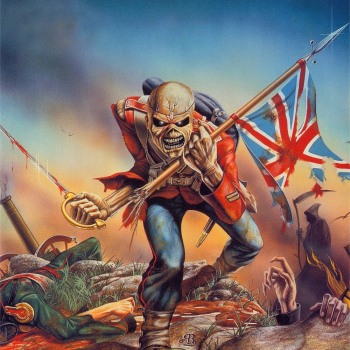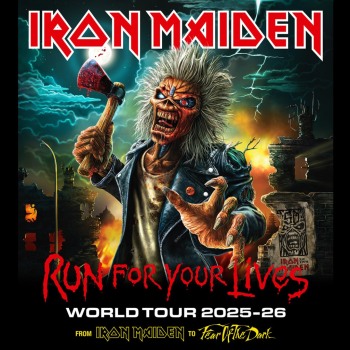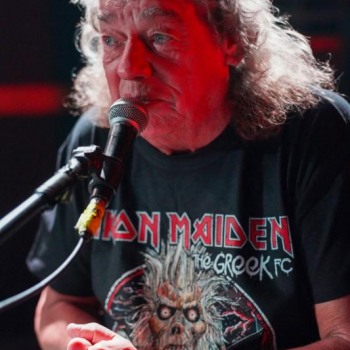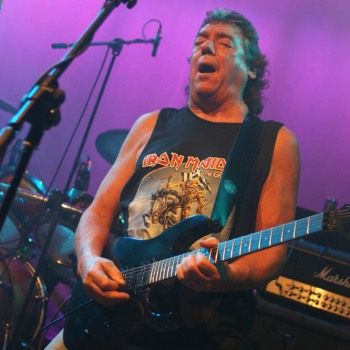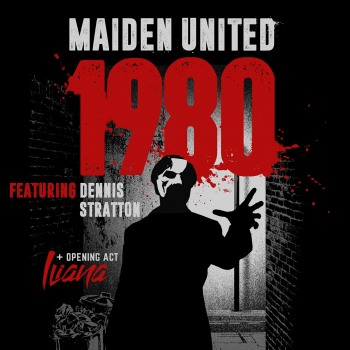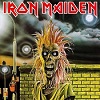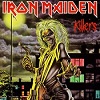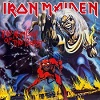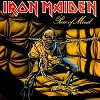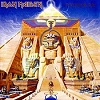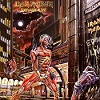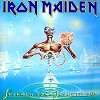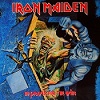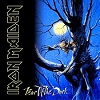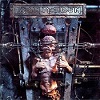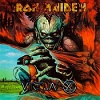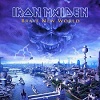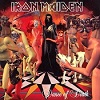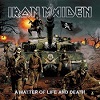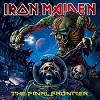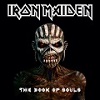Eddie, also known as Eddie the Head, is the mascot for the British heavy metal band Iron Maiden. He is a perennial fixture of the group's artwork, appearing in all of their album covers (as well as most of their singles) and in their merchandise, which includes t-shirts, posters and action figures. On top of this, Eddie features in all of the band's concerts, as well as in the first-person shooter video game, Ed Hunter, and as an unlockable character in Tony Hawk's Pro Skater 4.
Originally a papier-mâché mask used in Iron Maiden's stage backdrop, the band transferred the name "Eddie" from the mask to an illustration by Derek Riggs, which was used as the band's debut album cover. Although he is occasionally described as "zombie-like" in the press, Eddie assumes a different guise relating to the themes of individual albums and their corresponding world tours, and has appeared as a cyborg, an Egyptian mummy and a lobotomised mental patient amongst others.
Background
The very first version of Eddie was a mask made by an art student who was friends with Dave (Lights) Beasley, then in charge of lighting, pyrotechnics and other effects for Iron Maiden's live-show. According to Lights, the original mask was a papier-mâché mould of his own face, which was then used in the band's backdrop, consisting of LED lights and the band's logo. At the end of their live set, during the "Iron Maiden" song, a fish-tank pump was used to squirt fake blood out of the mask's mouth, which typically covered their drummer, Doug Sampson. After this initial incarnation, Lights constructed a larger mask out of fibreglass, equipped with flashing eyes and the ability to release red smoke from its mouth.
The band's bassist and founder member, Steve Harris, states that the name "Eddie" comes from the fact that said mask was referred to as "The Head", which sounded like "Ead" in the band members' London accent. According to guitarist Dave Murray the name was also inspired by an old joke:
"A wife had a baby, but it was born with only a head and no body. 'Don't worry,' says the doctor. 'Bring him back in five years time and we'll probably have a body for him'. So five years go by, and there's Eddie the 'Ead, as his parents have called him, sitting on the mantelpiece, when in walks his dad. 'Son,' he says, 'today's a very special day. It's your fifth birthday and we've got a very special surprise for you.' 'Oh no,' says Eddie. 'Not another fucking hat!'"
Once Iron Maiden had secured a record contract with EMI, the band's manager, Rod Smallwood, decided that the band needed "that one figure who utterly stamped his presence and image on the band in a way that was obvious enough to make a good album cover." After seeing some of his artwork on a Max Middleton poster, Smallwood set up a meeting with Derek Riggs and asked to see some of his other illustrations, in the midst of which was the band's first album cover. Originally created as an idea for a punk record, which Riggs states in the 12 Wasted Years documentary was based on an alleged American's skull stuck to a Vietnamese tank, the band had extra hair added to the illustration, making it more suitable to their style of music, and transferred the name from the original masks they used onstage. Surmising that the creature had "great visual continuity," Smallwood decided it would be used for all of the band's artwork.
Smallwood claims that Rupert Perry, EMI's then managing director, came up with the idea that Eddie could become a more active part of the band's concerts, originally portrayed by Smallwood himself, wearing an Eddie mask and a leather jacket. The classic "walk-on" Eddie was created for The Beast on the Road tour by Dave Lights after seeing a pantomime version of Jack and the Beanstalk, which used similar giants consisting of "basically a bloke on stilts but dressed up to look about ten feet tall." As the band's stage show expanded, an additional gigantic Eddie was also incorporated at the back of the set during "Iron Maiden", which, like the "walk-on" Eddie, would match the theme of the current tour, such as the 30-foot, mummified version used during the World Slavery Tour which shot sparks from its eyes.
Eddie's debut appearance was on the band's first single cover, "Running Free," in which his face was covered by shadow to protect his identity before the release of the band's first album. Since then, Eddie has assumed a different guise for each cover, such as a "mummified Egyptian god" for Powerslave, a lobotomized mental patient for Piece of Mind, emerging from a grave in Live After Death, and a cyborg for Somewhere in Time.
Controversy
Some of the band's artworks have proved controversial, such as the cover of "Sanctuary," in which Eddie can be seen standing over the corpse of Margaret Thatcher. It was claimed that Iron Maiden were banned from releasing the single without censoring the cover, blacking out Thatcher's face, although Riggs has since claimed that this was fabricated by the band's management to gain publicity in the British tabloids.
The most amount of controversy, however, was reserved for the band's third album, The Number of the Beast, whose artwork depicted Eddie controlling Satan like a marionette. Originally created by Riggs for the "Purgatory" single cover, but deemed too good by Smallwood and withheld for the next studio release, the image, along with the record's title track, led to the "moral majority" labelling Iron Maiden as Satanists and organising public burnings of their back-catalogue in the United States, which in turn gave them a large amount of publicity.
During the course of the Troubles in Northern Ireland, Eddie the Head, specifically as he appeared on the sleeve of "The Trooper", became an unofficial mascot of the Ulster Freedom Fighters loyalist paramilitary group and was the main figure on a number of the group's murals. The loyalist representation frequently carried a tattered flag with the emblem of the Ulster Defence Association rather than the Union Flag as on the Iron Maiden sleeve.
During The Final Frontier World Tour in 2011, after Iron Maiden did not perform "The Trooper" in Belfast, Blabbermouth.net reported that there had been speculation amongst fans that this was due to the artwork's use in murals.
Recognition
Gibson.com described Eddie in 2008 as "the most recognizable metal icon in the world and one of the most versatile too," while in 2009 Gigwise called him "perhaps the most enduring band mascot of all time." Many artists who have been influenced by Iron Maiden hold their artwork in high regard, with Joey Jordison of Slipknot commenting that he bought his first album "on the strength of the cover alone" and Corey Taylor, also of Slipknot, stating that "there wasn't a dude that I hung out with that wasn't trying to draw Eddie on their schoolbooks." Steve-O, from Jackass, says that they have "the coolest album covers in the music industry" and Lars Ulrich, of Metallica, comments that "they had the best packaging, the coolest T-shirts — everything." Mick Wall describes Eddie as "the immortal soul of Iron Maiden, the defining symbol of the eternally youthful, blissfully uncompromising spirit of the band's music."
In 2008, Eddie won the "Icon Award" at the Metal Hammer Golden Gods.
Other Artists
From 1980 onwards, the band's Eddie artwork was provided exclusively by Derek Riggs until 1992, when the band decided to accept contributions from other artists, with Smallwood explaining that they "wanted to upgrade Eddie for the '90s. We wanted to take him from this sort of comic-book horror creature and turn him into something a bit more straightforward so that he became even more threatening." Since then, Riggs has contributed much less to the band's artwork, creating part of one studio album, one single and two compilation covers, while the band have employed a number of different artists:
- Melvyn Grant first drew Eddie for the Fear of the Dark sleeve, the first time anyone other than Riggs had designed a cover for Iron Maiden in which Eddie was pictured. Grant also worked on the Virtual XI, Death on the Road, "The Reincarnation of Benjamin Breeg", The Final Frontier and From Fear to Eternity covers.
- Mark Wilkinson depicted Eddie as a bat for the poster of their 1992 Monsters of Rock appearance, which was later used for the cover of the Live at Donington remaster. Wilkinson has also contributed to "The Wicker Man" and "Out of the Silent Planet" singles, as well as the Best of the 'B' Sides album.
- Hugh Syme, noted for both his album cover work and guest musician appearances for the Canadian progressive rock band Rush, provided the artwork for The X Factor, the band's first digitally illustrated cover.
- Tom Adams provided the artwork to Edward the Great, showing Eddie as a King on a throne.
- Although not listed on the record's release, the From Fear to Eternity album sleeve credits David Patchett with creating the Dance of Death cover. The artwork was negatively received, with Sputnikmusic deeming it "terrible."
- Tim Bradstreet, best known for his contributions to The Punisher comics, created the cover of A Matter of Life and Death.
- Anthony Dry created the "El Dorado" and "The Final Frontier" radio promo covers, featuring Melvyn Grant's The Final Frontier Eddie in a comic book cover style.
Various Incarnations
- Iron Maiden, the first artwork featuring Eddie, originally created for a possible punk record, based on an American's head allegedly stuck to a Vietnamese tank.
- "Running Free", the band's first release to depict Eddie, painted after the album cover so his face was hidden to protect his identity.
- "Sanctuary", showing Eddie above Margaret Thatcher's corpse, wielding a knife. According to Riggs, the band's management censored the image themselves to gain publicity.
- "Women in Uniform", according to Riggs features Margaret Thatcher getting "her own back" on Eddie.
- Killers, featuring Eddie with an axe and his victim clawing at his shirt. Based on a block of flats in which Riggs lived at the time, it contains several references to the band, such as the "Ruskin Arms" and "Charlotte the Harlot".
- "Twilight Zone", features Eddie's spirit reaching towards a woman through a mirror. According to Rod Smallwood, Iron Maiden's manager, the band were criticised as Eddie appeared to be attacking the woman.
- "Purgatory", depicts the devil's face crumbling away to reveal Eddie.
- Maiden Japan, shows Eddie with a Samurai sword. The cover was painted at short notice as the original, featuring Eddie decapitating Paul Di'Anno, was withdrawn as the band were considering replacing him.
- The Number of the Beast, depicts Eddie controlling the Devil like a puppet, who, in turn, also controls a puppet Eddie, causing controversy with American evangelists. Originally painted for the "Purgatory" song, Smallwood withheld the artwork for the following album, deeming it too good for a single.
- "Run to the Hills", shows Eddie fighting Satan with a Native American tomahawk, a reference to the song itself.
- "The Number of the Beast", the single cover showing Eddie holding the devil's decapitated head, which Riggs claims was meant to look like Salvador Dalí.
- Piece of Mind, a lobotomised Eddie, in a straightjacket, is chained at the neck to a padded cell.
- "Flight of Icarus", shows a winged Eddie torching Icarus, which Riggs states was meant to look like Led Zeppelin's Swan Song logo. The painting also contains a small box, meant to be Eddie's Piece of Mind padded cell.
- "The Trooper", depicts Eddie in a red coat uniform, during the Charge of the Light Brigade.
- Powerslave, featuring a statue of Eddie as an Egyptian Pharaoh/God.
- "2 Minutes to Midnight", showing Eddie sitting in front of an atomic explosion.
- "Aces High", depicts Eddie in a Spitfire cockpit.
- Live After Death, shows Eddie rising from the grave.
- "Run to the Hills (live)", contains live versions of "Run to the Hills" and "Phantom of the Opera" and so featured Eddie as the phantom in a hilly landscape.
- Somewhere in Time, Eddie appears as a cyborg in a Blade Runner-inspired future. The cover is notable for containing dozens of Easter eggs relating to the band and pop culture references.
- "Wasted Years", as the single came out before the album, the band did not want to reveal Eddie's new cyborg guise, so appears as a reflection in a time machine.
- "Stranger in a Strange Land", depicts Eddie as Clint Eastwood in a Star Wars-esque bar.
- Seventh Son of a Seventh Son, depicts a surreal Eddie with most of his body removed, which Riggs claims was because he was "sick of painting him" and this would mean there would not be as much of him to draw. Riggs also comments that he set it in a "polar landscape" after seeing a documentary on the North Pole, and that Eddie's head on fire was inspired by Arthur Brown.
- "Can I Play with Madness", shows Eddie's brain being destroyed.
- "The Evil That Men Do", according to Riggs he drew the artwork in a single night.
- "The Clairvoyant", depicts Eddie with three faces, indicating the ability to see the past, present and future.
- "Infinite Dreams"/ Maiden England, featuring Eddie riding a motorcycle.
- No Prayer for the Dying, shows Eddie bursting out of another grave. Unlike the band's previous artworks, in which he would retain the same features gained with each release (such as the Piece of Mind lobotomy), Eddie returned to how he was in the first few albums.
- "Holy Smoke", depicting Eddie destroying a group of televisions broadcasting TV evangelists, who the song itself attacks.
- "Bring Your Daughter... to the Slaughter", featured several different covers, such as one in which Eddie is stood outside "The Paradise Club" (a British TV series which Bruce Dickinson featured in) with Jessica Rabbit, and one in which Eddie appears as the Grim Reaper in a graveyard.
- Fear of the Dark, the first cover not created by Derek Riggs, features Melvyn Grant's design of Eddie as a tree monster.
- "Be Quick or Be Dead", shows Eddie attacking Robert Maxwell. According to Riggs, Eddie was drawn directly onto a photo of Maxwell.
- A Real Live One, depicts Eddie biting through an electrical cord.
- "Fear of the Dark (live)", according to Riggs shows Eddie as Steve Harris. The artwork was also used for the Raising Hell video.
- A Real Dead One, features Eddie as a radio DJ.
- "Hallowed Be Thy Name (live)", as lead vocalist Bruce Dickinson was leaving, the artwork depicts him being killed by Eddie, who appears as the devil.
- Live at Donington, re-release depicts Eddie as a bat, originally created by Mark Wilkinson for the Monsters of Rock 1992 poster.
- The X Factor, created by Hugh Syme, shows Eddie on an operating table with most of his insides showing. Due to the cover's graphic nature, the band had to provide a less-violent alternative consisting of a similar Eddie from a distance.
- "Man on the Edge" is a close-up of the model's head.
- "Lord of the Flies", also by Syme, has Eddie in an electric chair surrounded by two giant flies.
- Best of the Beast, features a selection of Riggs' past Eddies.
- "Virus", two covers, one by Syme, and one by Riggs featuring Eddie on a printed circuit board.
- Virtual XI, Eddie reaches towards a child wearing a virtual reality headset, created by Melvyn Grant.
- "The Angel and the Gambler", Eddie with wings standing outside a floating casino, created by Derek Riggs.
- "Futureal", also by Riggs, Eddie appears as a statue head with his brain exposed. Alternate covers for these two singles are renders of Eddie as he would appear in Ed Hunter.
- Ed Hunter, featuring the version of Eddie used in the game.
- Brave New World, this Eddie originally appeared in a cloud of smoke coming from a burning "Wicker Man" Eddie, a piece of artwork created by Derek Riggs, but was removed and placed into the album art, wherein his cloud form looms over a futuristic version of London.
- "The Wicker Man", Eddie appears as a Wicker Man, created by Mark Wilkinson.
- "Out of the Silent Planet", features Eddie at a press conference, also designed by Wilkinson. An alternate cover uses the same Eddie from the Brave New World cover.
- Rock in Rio: in both the CD and the DVD, as a cloud similar to the Brave New World cover, but looming over the Rock in Rio stage where the band played instead.
- BBC Archives, created by Derek Riggs for Billboard, the artwork originally depicted Eddie destroying Capitol Records (with whom they had just signed) with the pole of a British flag, but the building was changed for the album cover to him destroying the Broadcasting House instead.
- Beast over Hammersmith, shows Eddie planting a British flag in the earth, adapted from The Beast on the Road tour programme from 1982, drawn by Derek Riggs.
- Best of the 'B' Sides, depicts Eddie mooning from behind the wheel of a truck (with the words "Up the Irons" written across his rear end), illustrated by Mark Wilkinson. Wilkinson also designed the Eddie's Archive embossed metal case.
- Edward the Great, showing Eddie on a throne in full royal regalia, was created by Tom Adams.
- Dance of Death, features Eddie as the Grim Reaper, created by David Patchett.
- "Wildest Dreams", shot of Eddie in a top hat from the "Wildest Dreams" music video.
- "Rainmaker", cover also taken from its music video.
- Death on the Road, features Eddie as an undertaker, designed by Melvyn Grant.
- A Matter of Life and Death, shows Eddie riding a tank, created by Tim Bradstreet.
- "The Reincarnation of Benjamin Breeg", depicts Eddie destroying the grave of Benjamin Breeg, created by Melvyn Grant.
- "Different World", cover is a still from the song's music video.
- Somewhere Back in Time, shows the cyborg Eddie (from Somewhere in Time) erupting from the Powerslave statue.
- The Final Frontier, shows Eddie as an Extraterrestrial retrieving a key from a space ship. The artwork caused controversy as it was vastly different from the band's past covers, leading to many fans claiming that it was not Eddie. Melvyn Grant himself has since stated that the new monster "is not Eddie," although the band members state that it is.
- The "El Dorado" and "The Final Frontier" radio promo covers, featuring Grant's new Eddie in a comic book sleeve, were created by Anthony Dry.
- From Fear to Eternity, created by Melvyn Grant, shows three different incarnations: the Wicker Man Eddie from the "Wicker Man" single, the tank-riding Eddie from the A Matter of Life and Death album cover and a cross between the Dance of Death, Fear of the Dark and The Final Frontier Eddies.
